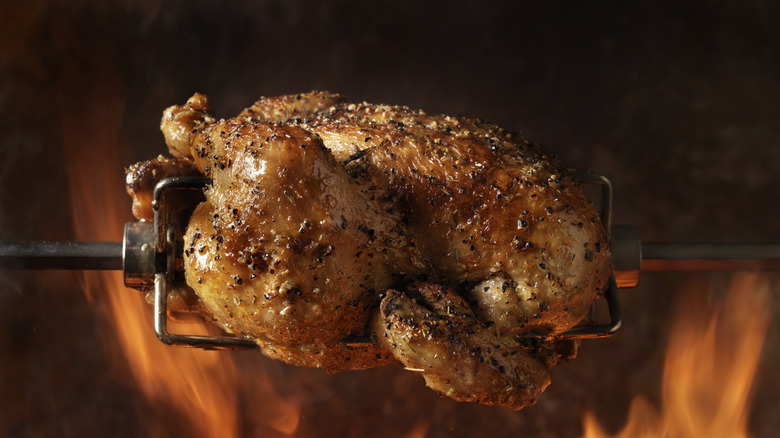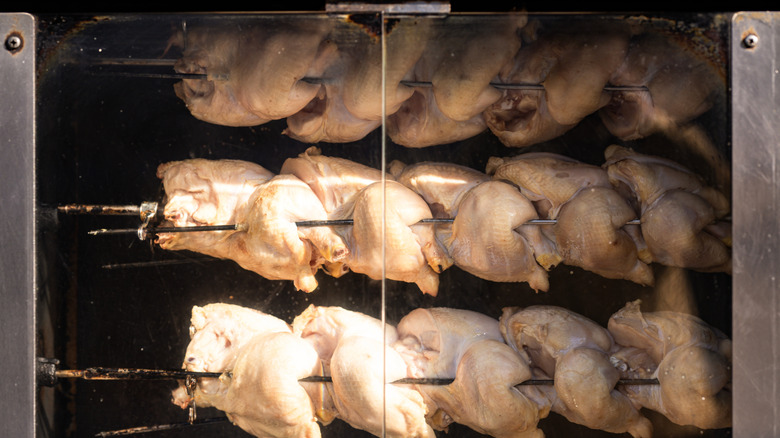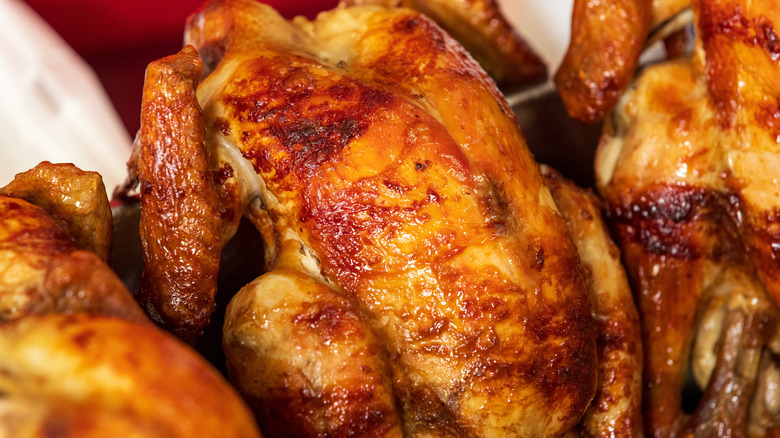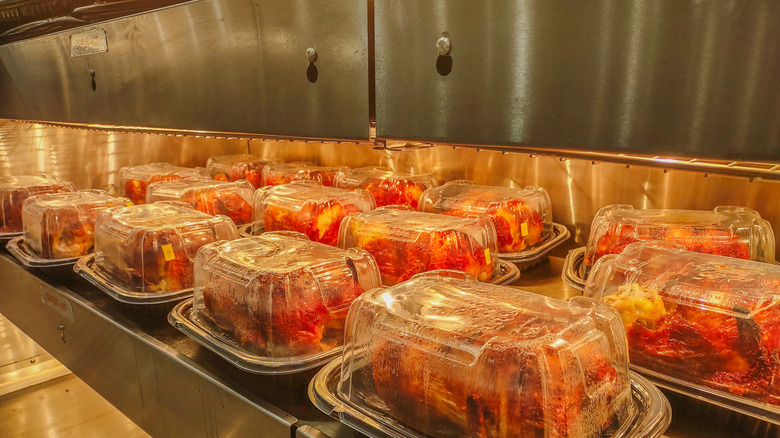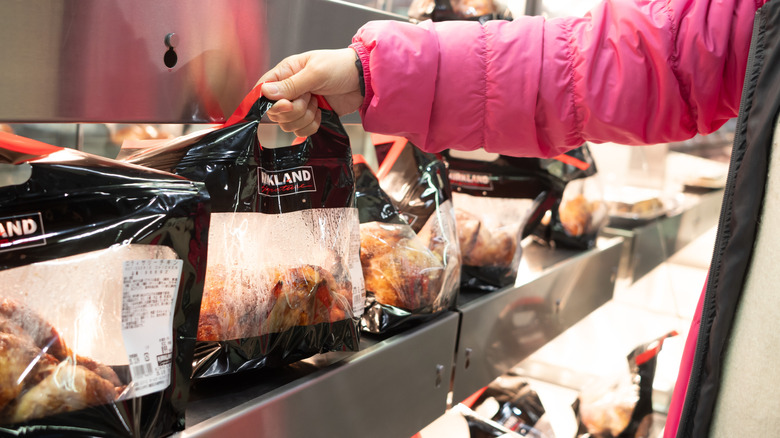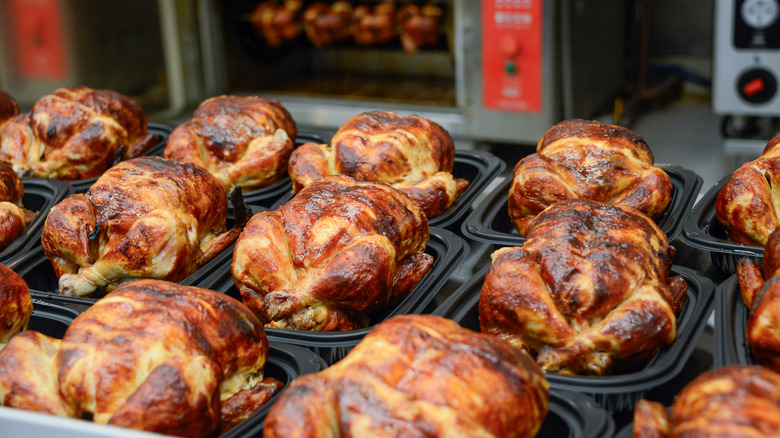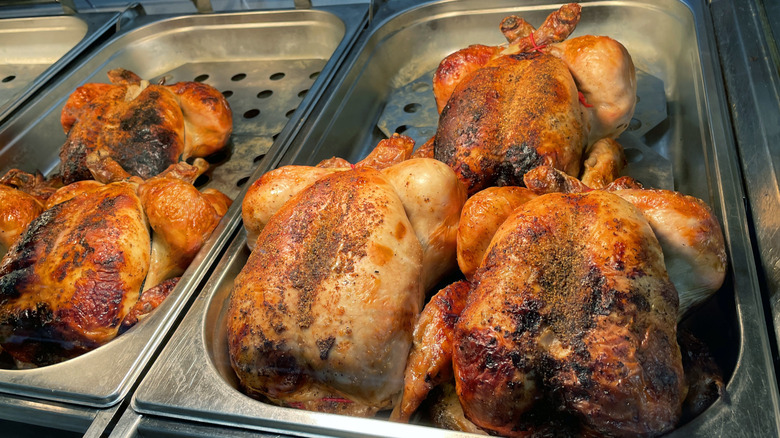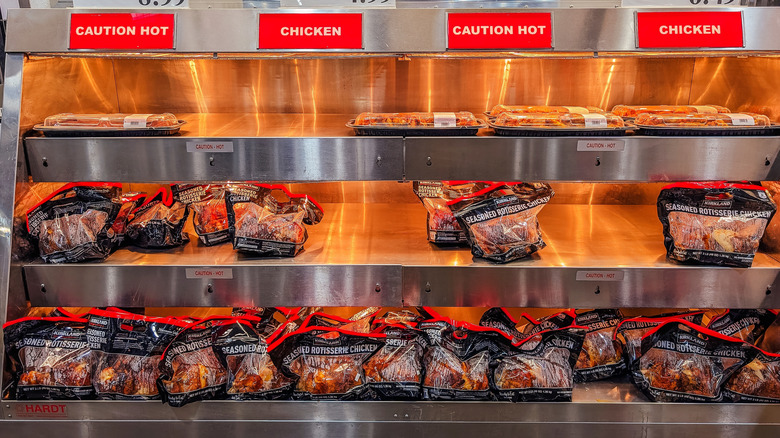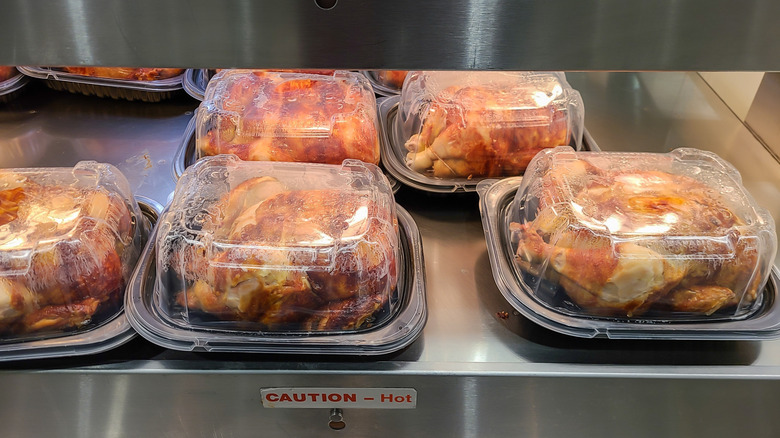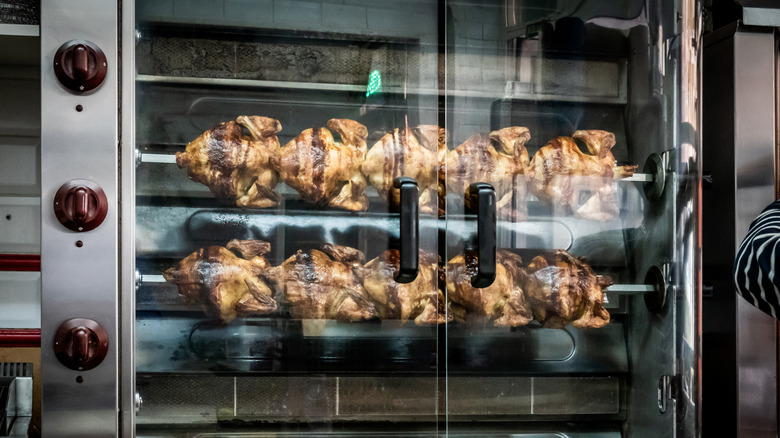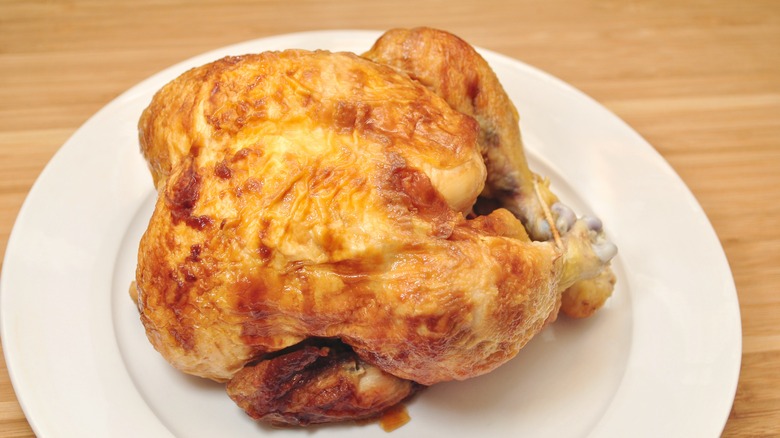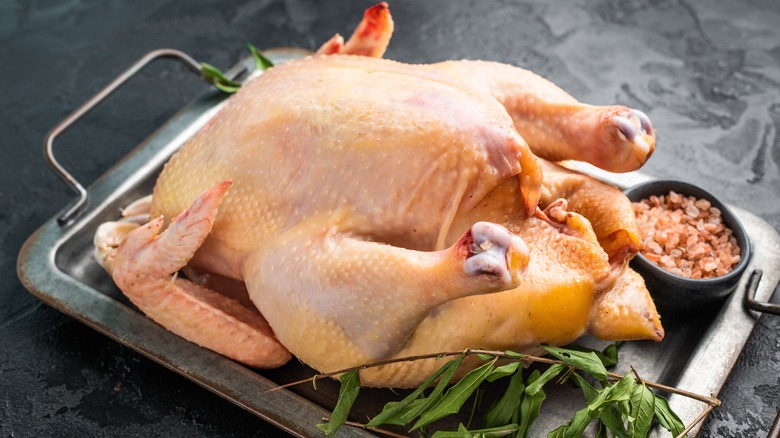The Biggest Red Flags To Look Out For When Buying A Grocery Store Rotisserie Chicken
Rotisserie chickens have become a grocery store staple, especially in recent years, and sales have skyrocketed into the hundreds of millions at stores like Costco. You may have grabbed a rotisserie chicken and some pre-made sides from your deli for a quick weeknight meal, or bought it to use as a shortcut in other dishes. In fact, there's loads of genius tricks for using up your leftover chicken, so it is a cost-effective purchase as well as a tasty one. Rotisserie chickens are also known for being a healthier option than their fried counterparts — although it is worth reading into the nutritional information in more detail before you purchase from a store.
If you have sampled enough rotisserie chickens, chances are that you have also had some lackluster poultry purchases as well as some standout ones. While it may seem like all rotisserie chickens are basically the same when they are loaded into the glass serving cases, there is some technique behind finding the perfectly moist chicken. Read on to find some of the biggest rotisserie chicken red flags to look for next time you are at the grocery store, as well as some tips for picking the best bird.
The chicken is lacking color
One of the easiest (and most obvious) ways to tell if you have a high-quality grocery store chicken is to take note of the chicken's appearance. You typically want to see a rotisserie chicken that is evenly browned, preferably with visible herbs or spices, to show that it is seasoned well. If the chicken is a pale color or there is uneven browning, you may want to steer clear. This can be a sign of bland flavor, and potentially uneven cooking.
However, there is such a thing as the chicken being too flavorful. If a chicken has been overseasoned, that may impact on what you plan to do with it when you get it home. Keep in mind the innate saltiness of your rotisserie chicken if you plan to use it in another dish when adding your seasoning at home. Making a stew or your own chicken stock are two examples where some of the flavored varieties of rotisserie chicken may clash with dish flavors. If you're just enjoying the chicken on its own with some sides, go ahead and enjoy some zesty flavors like lemon pepper or barbecue.
The skin is cracking and is not taut
Another big red flag for rotisserie chicken on the appearance front is the skin. We all love when rotisserie chickens have that perfectly browned and crisp skin. The coloring not only looks appealing, but the crisp texture is also tasty. The skin's texture can also be a telltale sign of an overcooked bird, and a dry chicken as a result.
If you can see that the skin is cracking throughout the body or breaks apart at the joints of the chicken, it may have been cooked too long or at too high a temperature. You may also notice that the skin on some rotisserie chickens begins to shrivel up and no longer tightly covers the meat anymore. The skin's elasticity and color are affected when juices begin to evaporate from the meat. That means if the chicken's skin appears to still be tightly intact, the moisture likely hasn't left the meat.
The chicken is on the light side weight-wise
Whether your reason to find the largest chicken is to get the best bang for your buck or a need to feed a large group, you may find yourself avoiding the smaller chickens. Rotisserie chickens typically have their weight listed on the packaging, making it easy to compare them. Whatever method you choose, a heavy chicken many times means the juices likely stayed in the meat and have not evaporated. Some chefs swear that you can tell the difference between chickens that have been in the case all day versus fresh ones by lifting the chicken on your own. You may feel silly lifting each package like weights at a gym, but this method can lead you to finding the juiciest chicken that yields more leftover opportunities.
That's not to say that all smaller rotisserie chickens will be subpar. In fact, a smaller chicken can be an ideal choice for those looking for smaller portions at a cheaper price. Even stores like Costco discount their standard $5 chicken prices for lighter birds, moving to a price per pound model.
There is extra liquid in the package
You may have noticed extra liquid at the bottom of the rotisserie chicken container. This can be considered a red flag in some cases, as the excess liquid could be juice that has escaped the chicken. Depending on how moist your chicken was to begin with, you may find that your chicken is now dry (which is especially disappointing when it comes to the naturally leaner white meat). However, that isn't necessarily always the situation every time. You could have just picked an extra juicy rotisserie chicken, explaining the extra liquid found in the packaging. Unfortunately, you won't know until you get it home and start cutting. Don't throw away the juices from your rotisserie chicken, though, you can repurpose it for dressing or gravy.
Another reason you may find the packaging soggy is that the steam from the chicken turns into water as it cools. The shift from steam to water droplets can be a sign that your rotisserie chicken has been sitting out for too long. In that case, you may find a pool of water at the bottom of your rotisserie chicken package. You can detect extra water by tipping the plastic container from side to side, or by checking the bottom of the bag.
Temperature control issues
One factor you don't want to mess with when it comes to poultry in particular is the temperature. Your rotisserie chickens shouldn't be kept out at room temperature on the store floor due to food safety issues. A general rule of thumb is that cooked chicken should be cooled at below 40 degrees Fahrenheit or heated to a temperature of above 140 degrees Fahrenheit. This temperature gap is especially important due to the "danger zone" where bacteria grow. If your rotisserie chicken temperature drops below 140 degrees (and is not preserved in a refrigerator at under 40 degrees), it could become unsafe to eat after a mere four hours. In fact, it is recommended not to leave cooked chicken at room temperature for more than two hours. This means you also want to consider transporting your cooked rotisserie chicken in an insulated container or on ice if you don't plan to go home from the store right away.
So if you are perusing your grocery store and find rotisserie chickens on a display that has no temperature regulation controls, you will want to steer clear. You ideally want to find rotisserie chickens displayed in a heated case with a temperature regulation system, where store employees check the temperatures on a regular basis.
Chicken counter is overstocked
Your initial reaction to a fully stocked rotisserie chicken counter may be a positive one. Lots of choices are a good thing, right? However, a surplus of rotisserie chickens sitting out for hours at a time can be a sign of poor quality, as there isn't a customer demand for the chickens. Excess rotisserie chickens also mean that there isn't a turnover of product, so the case isn't being refreshed throughout the day. While seeing this just one time on a store visit isn't necessarily a bad thing (you may just hit the restocking timeframe right), if you are regularly seeing rotisserie chickens piled up, it may be cause for pause. If you see a line at the deli waiting for rotisserie chickens to be restocked, that may be a sign that it is in demand, and the quality makes it worth waiting for a fresh rotisserie chicken.
And if you are concerned about food waste, when you look at the case full of rotisserie chickens, don't fret. Many stores use unsold rotisserie chickens to make other chicken dishes sold in the prepared foods section of the deli, like chicken salad. So you shouldn't assume all the birds will go to waste if they aren't purchased.
Chickens are still available at closing time
There isn't a hard and fast rule about when rotisserie chickens are freshest, as each store has its own preparation schedule. Some stores start the rotisserie when it opens in the morning, with the typical rotisserie chicken taking a few hours to cook, while others start the process before opening. While you likely won't find a fresh rotisserie chicken bright and early in the morning, the late morning pre-lunch store visits should get you close to the first and freshest set.
However, if you are at your grocery store right up until closing time, you may want to pay a little closer attention when selecting your chicken to find the freshest option. This doesn't necessarily mean the birds aren't fresh, but considering the longer cooking process, you likely won't see workers bringing out fresh new rotisserie chickens within an hour of closing. Looking at the timestamp on the packaging can be your first tactic for picking the freshest option. You can also ask your deli what their cooking schedule is to try to hit the rotisserie rotation as closely as possible.
The chicken has a reduced price
We all love a bargain, so those reduced price stickers can be a welcome sight when walking through the grocery store. But when it comes to prepared deli items like the rotisserie chickens, it may be a sign that it has been sitting out long enough to be too close to the "sell-by date." It should be noted that the U.S. Department of Agriculture's definition of "sell-by date" refers to how long the store should keep its products on display from an inventory perspective and is not necessarily related to food safety. The bargain sticker could also mean the chicken is reaching the brink of being unsellable due to food safety temperature regulations, where employees monitor temperatures and pull items deemed too cold to sell.
Price reductions can also be a tactic by the grocery store to respond to a surplus of product in its inventory. By providing a flash sale of sorts, stores can maximize profits off their product before it is no longer sellable. If you are shopping at a big-box store like Costco or Sam's Club, the price of the rotisserie is likely already cheaper than its competitor stores, so you probably won't see a discount. Stores actually take a profit hit on rotisserie chickens to get customers in the store to then buy other items.
There is no rotisserie cooker in sight
One would assume that a rotisserie chicken is actually cooked on a rotisserie. A rotisserie is defined as a device that cooks meat by turning it slowly near a flame or an enclosed stove/oven. You probably have seen these large ovens turning whole chickens around slowly behind the deli counter, roasting them to the glorious, evenly browned birds that we love. Experts say that you can probably assume that the stores that have the cooking displayed are rotating fresh rotisserie chickens to the customer displays throughout the day. But you may run into some establishments that don't have the ovens on display for customers to ogle at for one reason or another.
In these cases, don't be afraid to ask your grocer how the chicken is prepared and how often they restock their prepared foods. Not having an oven out for all to see doesn't necessarily mean that the rotisserie chicken isn't high-quality, but asking the question can be a lesson on how to evaluate the reputation and quality of your local establishment. You want to be able to trust your grocer to have the freshest, high-quality food prepared for its customers, and if you have any qualms about the food preparation, you may want to find another chicken source. Finding the "best" quality chickens may even surprise you with the search results. Experts note that the smaller international stores may have tasty (and arguably better quality) options than larger chains.
The ingredient label is long
A hot topic among many is clean eating and being mindful of what exactly is in our food. This means you want to study the ingredient label of your rotisserie chicken. Using the Kirkland rotisserie chicken as an example, the label shows ingredients like salt, sodium phosphates, hydrolyzed casein, modified corn starch, sugar, dextrose, chicken broth, isolated soy protein, lecithin, and mono- and diglycerides. The sodium phosphate ingredient is one of concern as it can cause some health issues for people who have kidney disease, intestinal blockages, colitis, or heart failure. Sodium phosphate is used in foods to prevent bacterial growth, add texture and as an emulsifer of flavors. Nutritionist Robin Miller tells Mashed.com that sodium phosphate has been linked to chronic kidney disease in those without renal functioning issues. It should be noted that the U.S. Food and Drug Administration calls sodium phosphate "generally recognized as safe," possibly because the amount added to foods is low. While you don't have to stay away from rotisserie chicken entirely for this reason alone, just be mindful of your intake.
Not all rotisserie chickens contain that long ingredient list. Whole Foods offers an organic rotisserie chicken with minimal ingredients and lower sodium levels than other grocery store chains. Kroger's Simple Truth brand rotisserie chicken has a short ingredient list of chicken, water, and sea salt. Your best bet for knowing exactly what's in your rotisserie chicken is to make one at home.
The chicken is the largest one
On the other hand, going for the largest bird for the biggest bang for your buck can have some negative repercussions. Some rotisserie chicken enthusiasts say they pick their poultry based on whether the top of the chicken touches the clamshell container lid, signifying a chicken that's on the larger side. However, some shoppers have reported that the larger rotisserie chickens can sometimes have issues with quality, including not being cooked all the way through.
Unfortunately, you won't know if your chicken isn't fully cooked until you get home, since you can't necessarily stick a meat thermometer in the chicken in the store. Selecting a medium-sized chicken can give you a little more peace of mind that the chicken is likely cooked through, but not too overcooked, like some of the smaller birds may fall victim to. And if you find yourself in the undercooked chicken situation, you can try reheating your rotisserie chicken in the air fryer before taking the internal temperature again. Not only can that get you into the internal temperature "safe zone," the air fryer can crisp up the exterior, giving it the "just came off the grill" texture and taste. An oven or stovetop reheat can also do the trick, but may not yield the same results.
The chicken is super salty
An underseasoned rotisserie chicken can be a big disappointment. Especially with the leaner cuts like the chicken breast that doesn't quite have the same flavor and moisture as dark meat chicken thighs or legs, the lack of seasoning can contribute to a subpar flavor experience. But there is too much of a good thing when it comes to seasoning in regard to salt. An oversalted chicken can be unpalatable and also affect the nutritional value of the chicken. If you have already patted yourself on the back for not choosing the fried chicken for health reasons, excess sodium can negate some of the gained health benefits from the grilled preparation.
Once again, you likely aren't going to get to taste test the rotisserie chicken before selecting yours. However, a telltale sign that a rotisserie chicken may be on the salty side can be particular ingredients listed on the packaging. You will want to exercise caution if you see brine or saline solution on the nutritional label, especially if it's up near the top of the list, as the U.S. Food and Drug Administration requires food manufacturers to list ingredients in order of greatest amount used. But if you don't have the brine-less or saline-free option, you can mitigate the extra sodium in your chicken by not eating the skin. The chicken skin is tasty, but it is also high in saturated fat and can hide a large amount of sodium, as some preparations have a salt-based seasoning on the skin.
